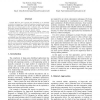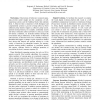87
Voted
SASO
2009
IEEE
15 years 7 months ago
2009
IEEE
—In sufficiently large heterogeneous overlays message loss and delays are likely to occur. This has a significant impact on overlay routing, especially on longer paths. The exi...
74
Voted
SASO
2009
IEEE
15 years 7 months ago
2009
IEEE
—We examine the use of teleological metareasoning for self-adaptation in game-playing software agents. The goal of our work is to develop an interactive environment in which the ...
88
Voted
SASO
2009
IEEE
15 years 7 months ago
2009
IEEE
—Controlling particle swarm optimization is typically an unintuitive task, involving a process of adjusting low-level parameters of the system that often do not have obvious corr...
121
click to vote
SASO
2009
IEEE
15 years 7 months ago
2009
IEEE
Abstract—Unstructured peer-to-peer networks can be extremely flexible, but, because of size, complexity, and high variability in peers’ capacity and reliability, it is a conti...
SASO
2009
IEEE
15 years 7 months ago
2009
IEEE
Creolization is a self-organization process of new language community. Thus far, a simulation study of the emergence of creoles has been reported in a mathematical framework. In t...
80
Voted
SASO
2009
IEEE
15 years 7 months ago
2009
IEEE
Delegate MAS has been proposed and investigated as an integrated coordination technique for so-called self-organising coordination-and-control applications. Delegate MAS consist o...
SASO
2009
IEEE
15 years 7 months ago
2009
IEEE
We investigate a generic self-adaptation method to reduce the design effort for System-on-Chip (SoC). Previous self-adaptation solutions at chip-level use circuitries which have b...
67
Voted
SASO
2009
IEEE
15 years 7 months ago
2009
IEEE
104
Voted
SASO
2009
IEEE
15 years 7 months ago
2009
IEEE
—Large-scale agent-based systems are required to self-optimize towards multiple, potentially conflicting, policies of varying spatial and temporal scope. As a result, not all ag...
SASO
2009
IEEE
15 years 7 months ago
2009
IEEE
Geographically embedded processes with hidden origins are often observable in events they generate. It is common practice in criminological forensics to reverse simple equation-ba...


